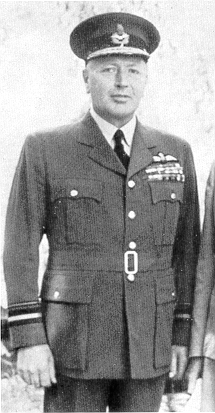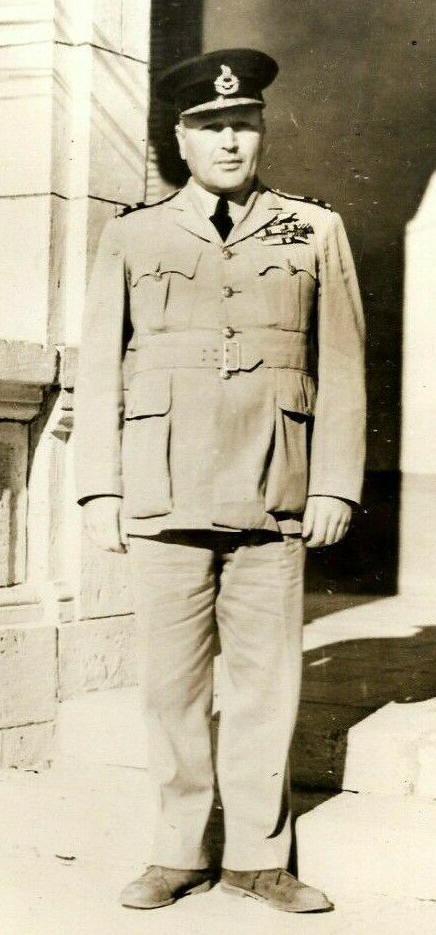Air of Authority - A History of RAF Organisation

Raymond
b: 22 Nov 1893
r: 29 Oct 1943
d: 29 Sep 1976
CB
- 4 Mar 1941, DSO - 11 Aug 1917, Bar - 21 Sep 1918,
OBE (Mil) - 16 Jul 1920, OBE (Civil) - 1 Jul 1946,
DSC - 20 Jul 1917, DFC - 3 Aug 1918,
SA2S - xx xxx xxxx, MiD - 11 Dec 1917,
MiD - 31 Dec 1918, MiD
- 31 Mar 1920, MiD - 10 Oct 1922.
For a list of foreign decoration abbreviations, click here
(RN):
- (P) Flt Sub-Lt: 10 Jan
1916, Flt Sub-Lt: 13 Jul 1916 [10 Jan
1916], Act
Flt Lt: 3 Jun 1916,
Flt Lt: 30 Jun 1917, Act Flt Cdr:
2 Jul - 3 Aug 1917, Flt Cdr:
31 Dec 1917, Act Sqn Cdr: 2 Jan 1918.
(RAF):
- (T) Maj [Lt]: 1 Apr 1918, Act
Maj: 1 Apr 1918, Flt Lt: 1 Aug
1919 [1
Apr 1918], Act Sqn Ldr: 1 Aug 1919-22
Apr 1920, Sqn
Ldr: 1 Jan 1922, Wg Cdr: 1 Jul
1929, Gp Capt: 1 Jul 1935, A/Cdre:
1 Apr 1939, Act
AVM: 21 Mar 1942, AVM:
Retained.
xx
xxx 1908: Seaman/Officer, Canadian Fisheries Protection Service.
3
Feb 1916:
U/T Pilot, RNAS Redcar
16
Jul 1916:
Attended Gunnery School, Isle of Sheppey
2
Aug 1916: Pilot, No 3 Wing RNAS. (Sopwith 11
Strutter Western Front)
1
Feb 1917: Pilot, No 3 Sqn RNAS. (Pup Western Front)
24
Mar 1917: Sick leave
27
Apr 1917: Flight Commander, No 10 Sqn RNAS. (Sopwith Triplane Western Front)
29 Jul 1917 Leave in Canada (Three months)
24
Nov 1917:
Flight Commander, Seaplane Defence Sqn RNAS. (Camel Dunkirk)
29
Dec 1917: Officer Commanding, Seaplane Defence Sqn RNAS. (Renamed No 13 Sqn)
15
Jan 1918: Officer Commanding, No 13 Sqn RNAS.
23 Jan 1918: Officer Commanding, No 3 Sqn RNAS
1 Apr 1918:
Officer
Commanding, No 203 Sqn RAF. (Camel Western
Front)
21 Oct 1918: Returned to Home Establishment
xx
xxx 1918:
Duties connected with planned return to Canada.
xx
xxx 1919: Leave in Canada.
10 Jul 1919: Arrived in South Russia from UK
11 Jul 1919:
Officer Commanding, No 47 Sqn (DH9, DH9A, Camel - South Russia) (renamed A
Sqn)
xx
Oct 1919: Officer Commanding, 'A' Sqn.
31 Mar 1920: Embarked for Constantinople
xx
May 1920: Leave in Canada
30 Aug 1920: Supernumerary, RAF Depot.
12
Nov 1920: Flight
Commander, No 30 Sqn. (DH9A Baghdad)
xx
xxx 1921:
Officer Commanding (acting), No 30 Sqn. (DH9A Baghdad)
27
May 1923: RAF Liaison Officer, 'Kurdistan Expeditionary Force' (Supernumerary, RAF
Depot)
1
Oct 1923:
Officer Commanding, No 41 Sqn. (Snipe, Siskin III Northolt)
5
May 1924: Attended
Course No 3, RAF Staff College.
14
Apr 1925: Staff, HQ No 6 Group.
1
Jul 1925:
Officer Commanding, No 23 Sqn. (Snipe/Gamecock Henlow)
18
Nov 1927: Head of Operations and Intelligence , HQ ADGB.
2
Aug 1929:
OC Flying, HMS Courageous.
xx
Jan 1930: Attended the Senior Officers' Technical Course.
29
Aug 1932: Supernumerary, RAF Depot.
1 Oct 1932: Supernumerary, RAF Bircham Newton.
15
Oct 1932: Officer Commanding, RAF Bircham Newton. (Nos 35 & 207 Sqns)
1
Jul 1935:
Officer Commanding, RAF Upper Heyford
10
Oct 1935:
Officer Commanding, No 5 Wing.
14
Aug 1936: Officer Commanding, RAF Heliopolis.
18
Apr 1939:
AOC, Egypt Group
21 Sep 1939:
AOC, No 202 Group.
12
Apr 1941:
AOC, No 204 Group.

xx
Aug 1941:
Air Staff, HQ Fighter Command.
21
Mar 1942: AOC, No 14 (Fighter) Group.
xx
xxx 1943 - xx xxx 1945:
Regional Air Liaison Officer, Civil Defence
Born
in British Colombia he was educated at the Naval College, Canada and joined the Canadian Fisheries Protection Service as a
cabin boy, continuing his studies he rose to seaman and later First Officer.
Some accounts of his career state that he served with Scott's ill fated
Antarctic expedition, but this was most certainly not case.
He managed to transfer to the RNAS, in 1915 but it was 1916 before he
began pilot training. By the end of
WW1, he had amassed a score of 60 enemy aircraft destroyed thereby making him
the third highest scoring Allied pilot of the War. On his return to England he
was asked to take command of a squadron of 'volunteers' to operate in Southern
Russia against the Bolsheviks, where he was credited with a further 19
victories. No 5 Wing, consisted of
the two units from Bircham and No 3 (Fighter) Squadron.
This re-inforcement of British forces in the Sudan was in response to the Italian invasion of neighbouring Abyssinia.
After retiring he remained in Britain as a Regional Liaison Officer for
Civil Defence until the end of the war, when he returned to his native Canada.
In the post war period, he set up a number of mining exploration companies
proving to be as capable in the commercial sphere as he was in the military.
Citation for the award of the Distinguished Service Cross
Flt.-Lieut. Raymond Collishaw, R.N.A.S.
In recognition of his services on various occasions, especially the following:
On June 1st, 1917, this officer shot down an Albatross Scout in flames.
On 3rd June, 1917, he shot down an Albatross Scout in flames.
On 5th June, 1917, he shot down a two-seater Albatross in flames.
On the 6th June, 1917, he shot down two Albatross scouts in flames and killed the pilot in a third. He has displayed great gallantry and skill in all his combats.
(London Gazette 20 July 1917)
Citation for the award of the Distinguished Service Order
"Fit. Lieut. Raymond Collishaw, D.S.C., R.N.A.S.
For conspicuous bravery and skill in successfully leading attacks against hostile aircraft. Since the 10th June, 1917, Fit. Lieut. Collishaw has himself brought down four machines completely out of control and driven down two others with their planes shot away. Whilst on an offensive patrol on the morning of the 15th June,1917,he forced down a hostile scout in a nose dive. Later, on the same day, he drove down one hostile two-seater machine completely out of control, one hostile scout in a spin, and a third machine with two of its planes shot away. On the 24th June,1917,he engaged four enemy scouts, driving one down in a spin and another with two of its planes shot away; the latter machine was seen to crash."
(London Gazette - 11 August 1917)
Citation for the award of the Distinguished Flying Cross
Lt. (T./Maj.) Raymond Collishaw, D.S.O., D.S.C.
This officer is an exceptionally capable and efficient squadron commander, under whose leadership the squadron has maintained a high place in the Army Wing. He has carried out numerous solo patrols and led many offensive patrols, on all occasions engaging the enemy with great bravery and fearlessness. Up to date he has accounted for forty-seven enemy machines, twenty-two in the last twelve months.
(London Gazette 3 August 1918)
Citation for the award of the Bar to the Distinguished Service Order
"Lieut: (T./Major) Raymond Collishaw, D.S.O. D.S.C., D.F.C. (late R.N.A.S.).
A brilliant squadron leader of exceptional daring, who has destroyed fifty-one enemy machines. Early one morning he, with another pilot, attacked an enemy aerodrome. Seeing three machines brought out of a burning hangar he dived five times, firing bursts at these from a very low altitude, and dropped bombs on the living quarters. He then saw an enemy aeroplane descending over the aerodrome; he attacked it and drove it down in flames. Later, when returning from a reconnaissance of the damaged hangars, he was attacked by three Albatross Scouts, who pursued him to our lines, when he turned and attacked one, which fell out of control and crashed.
(D.S.O. gazetted 11th August, 1917; D.S.C. gazetted 20th July,1917; D.F.C. gazetted 3rd August,1918.)
(London Gazette - 21 September 1918)
Further
reading: - Air Command, R Collishaw
Kimber & Co
This page was last updated on 16/03/25©
![]() P S Collins
P S Collins ![]()